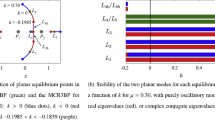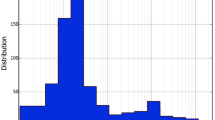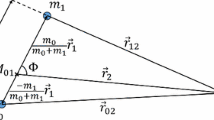Abstract
With improved observational capabilities and techniques, an increasing number of exoplanets have been discovered to orbit in the vicinity of binary star systems. In this investigation, periodic motions near a large mass ratio binary are explored within the context of the circular restricted three-body problem. Specifically, stability analysis is used to explore the effect of the mass ratio on the structure of families of periodic orbits. Such analysis is useful in a variety of applications, including the determination of potentially stable exoplanet motions near a binary star.



















Similar content being viewed by others
References
Benest, D.: Effects of the mass ratio on the existence of retrograde satellites in the circular restricted problem: IV. Three-dimensional stability of plane periodic orbits. Astron. Astrophys. 54, 563–568 (1977)
Bosanac, N.: Exploring the Influence of a Three-Body Interaction Added to the Gravitational Potential Function in the Circular Restricted Three-Body Problem: A Numerical Frequency Analysis. M.S. Thesis, School of Aeronautics and Astronautics, Purdue University, West Lafayette, Indiana (2012)
Bosanac, N., Howell, K.C., Fischbach, E.: Exploring the impact of a three-body interaction added to the gravitational potential function in the restricted three-body problem. In: 23rd AAS/AIAA Space Flight Mechanics Meeting, February 2013, Hawaii (2013)
Bosanac, N., Howell, K.C., Fischbach, E.: Stability of orbits near large mass ratio binary systems. In: 2nd IAA Conference on Dynamics and Control of Space Systems, March 2014, Rome, Italy (2014)
Contopoulos, G.: Order and Chaos in Dynamical Astronomy. Springer, Berlin (2002)
Fischbach, E., Talmadge, C.L.: The Search for Non-Newtonian Gravity. Springer-AIP, New York (1999)
Koon, W.S., Lo, M.W., Marsden, J.E., Ross, S.D.: Dynamical Systems, the Three Body Problem and Space Mission Design. Springer, New York (2006)
Kryszczynska, A., Colas, F., Descamps, P., Bartczak, P., Polinska, M., Kwiatkowski, T., Lecacheux, J., Hirsch, R., Fagas, M., Kaminski, K., Michalowski, T., Marciniak, A.: New binary asteroid 809 Lundia I. Photometry and modelling. Astron. Astrophys. 501, 769–776 (2009)
Parker, T.S., Chua, L.O.: Practical Numerical Algorithms for Chaotic Systems. Springer, New York (1989)
Perko, L.: Differential Equations and Dynamical Systems, 3rd edn. Springer, New York (2000)
Perryman, M.: The Exoplanet Handbook. Cambridge University Press, Cambridge (2011)
Raghavan, D., Henry, T.J., Masion, B.D., Subasavage, J.P., Jao, W., Beaulieu, T.H., Hambly, N.C.: Two suns in the sky: stellar multiplicity in exoplanet systems. Astrophys. J. 646, 523–542 (2006)
Seydel, R.: Practical Bifurcation and Stability Analysis: From Equilibrium to Chaos. Springer, New York (1994)
Sigurdsson, S., Richer, H.B., Hansen, B.M., Stairs, I.H., Thorsett, S.E.: A young white dwarf companion to pulsar B1620-26: evidence for early planet formation. Science 301, 193–196 (2003)
Sigurdsson, S., Thorsett, S.E.: Update on pulsar B1620-26 in M4: observations, models, and implications. In: Binary Radio Pulsars, ASP Conference Series Proceedings, January 2004, Colorado, vol. 328, pp. 213–223 (2004)
Szebehely, V.: Theory of Orbits: The Restricted Problem of Three Bodies. Academic Press, London (1967)
Acknowledgments
The authors wish to express their gratitude towards the School of Aeronautics and Astronautics at Purdue University and the Purdue University Lynn Fellowship. In addition, the authors thank Ph.D. student Cody Short for valuable suggestions. The authors also appreciate comments and suggestions from the reviewers.
Author information
Authors and Affiliations
Corresponding author
Appendix: Initial conditions for representative orbits in each family
Appendix: Initial conditions for representative orbits in each family
For each planar symmetric family examined in this investigation, truncated initial conditions are provided for a representative orbit at a single value of the mass ratio, \(\mu =0.30\). Each initial condition, \(\bar{x}_{IC}\), takes the form of a six dimensional state located at one of the two perpendicular intersections of the orbit with the \(x\)-axis, such that \(\bar{x}_{IC} = [x_{0}, 0, 0, 0, \dot{y}_{0}, 0]\). Integrating \(\bar{x}_{IC}\) for a time interval equal to the orbital period, \(T\), produces a periodic orbit. Accordingly, each of the nonzero state elements, \(x_{0}\) and \(\dot{y}_{0}\), as well as the period are provided in Table 1 in nondimensional units. Since the results of a numerical integration in a chaotic system depend upon the specific implementation (i.e., choice of integration scheme and tolerance, as well as numerical accuracy) these initial conditions are provided in truncated form and require differential corrections to recover an orbit that is periodic, to within a specified tolerance.
Rights and permissions
About this article
Cite this article
Bosanac, N., Howell, K.C. & Fischbach, E. Stability of orbits near large mass ratio binary systems. Celest Mech Dyn Astr 122, 27–52 (2015). https://doi.org/10.1007/s10569-015-9607-6
Received:
Accepted:
Published:
Issue Date:
DOI: https://doi.org/10.1007/s10569-015-9607-6




